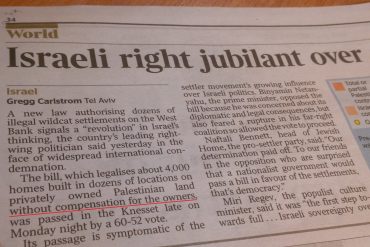1) At the Jerusalem Post Lahav Harkov highlights an issue ignored by the BBC in all its generous coverage of the US’ recognition of Jerusalem as Israel’s capital.
“Palestinian Authority President Mahmoud Abbas claims that he is a defender of Christian Arabs in areas under his control. He repeatedly said that Jerusalem is a Muslim and Christian – but not Jewish – holy city in his speech to the Organization of Islamic Cooperation last week.
But the Palestinians’ track record, even before putting a damper on Christmas this year, should leave Christians skeptical.
In 1950, the Christian population of the Bethlehem area was 86%, according to the National Catholic Reporter. Today, it’s only 12%, and Christians are only 2% of the Palestinian population, even though they were more than twice that a generation ago. The situation in Gaza, controlled by the terrorist group Hamas, is even worse. When Hamas took control in 2006, there were 6,000 Christians, and as of a year ago, there were 1,100. In Israel, the Christian population has stayed mostly stable at around 2%, growing by about 5,000 in the past 20 years.”
2) Writing at the Globe and Mail, Matti Friedman describes the Jerusalem that BBC audiences never see.
“When President Donald Trump announced on Dec. 6 that the United States would recognize Jerusalem as Israel’s capital and move its embassy here, Arab leaders called for “days of rage” and a chorus of Western observers predicted an explosion. The predictions were predictable; Jerusalem is always said to be on the brink of catastrophe, and headlines are always reporting “tensions.” […]
After Mr. Trump’s announcement, amid warnings of “explosive” repercussions, I got e-mails from friends abroad, wondering whether I was worried, or whether I was safe. That Friday, a crowd of reporters gathered at the Old City’s Damascus Gate to document the violence that was supposed to erupt. But little happened; the protesters were outnumbered by journalists, and everyone went home. There weren’t spontaneous mass celebrations on the Jewish side or mass disturbances on the Arab side. The past week has been fairly normal.”
3) Seth Frantzman of the Jerusalem Post investigates Qatari investment in Gaza.
“In October 2014, in the aftermath of the Gaza war (Operation Protective Edge), the UNRWA (United Nations Relief and Works Agency) estimated that more than 100,000 homes had been damaged or destroyed in the fighting, affecting 600,000 people. A total of $5.4 billion was pledged toward reconstruction efforts at an international conference in Egypt.
Two years later, only 51% of the pledged money had been disbursed. According to research by the Brookings Institution, Qatar was one of the biggest spenders investing in Gaza, with $216 million sent to the Strip by December 2016, part of a budget of $1.4b. it has pledged and spent in the last five years on Palestinians. […]
Israel has long known that cement imported to Gaza is diverted to be used by Hamas for building terrorist infrastructure, including tunnels. In a May 2016 speech, then-Foreign Ministry director-general Dore Gold said that for every 100 sacks of cement imported to the Gaza Strip, “only five or six are transferred to civilians.” He said that of the 4 million tons of building materials transferred to the Strip between October 2015 and May 2016, some of it had been “seized and used to build new attack tunnels.”
Qatar’s role in Gaza’s reconstruction puts it in a bind. Since June 2017 its neighbors in the Gulf have severed relations, accusing it of supporting terrorism. Doha’s support for Hamas is a central dispute between it and Riyadh.”
4) Israel’s state archivist Yaakov Lozowick writes about (and links to) the maps used by the British military in its Palestine campaign a century ago.
“Should we visit Tel Aviv? The name of the British map is Jaffa, and about the only part of modern Tel Aviv you’ll find is Sarona, and miles to the north the tiny Arab village of Sheikh Muannis, where Tel Aviv University is today. Also, the map helpfully notes the sand dunes at the center of today’s Tel Aviv.
But wait. That’s actually a bit odd. Tel Aviv was founded in 1909; at least a small version of it ought to have been on the British military maps printed in May 1917? Well, I recommend looking at the bottom right corner of the map, where it says that it’s a reprint made in May 1917, from… The Palestine Exploration Fund maps, surveyed in 1878!
This makes these maps even more interesting, because they tell us two very interesting things. The first is that when the British military map-makers needed to prepare maps with which to conquer Palestine, the most recent ones they had at hand were 39 years old, but they weren’t troubled because they knew that not much had changed between 1787 and 1917. Moreover, they were able to use the maps because their assumption about the limited change was basically correct. Here and there some changes had been made on the ground, such as the founding of the Jaffa suburb of Tel Aviv; but these changes weren’t significant enough to bother the military planners.”




